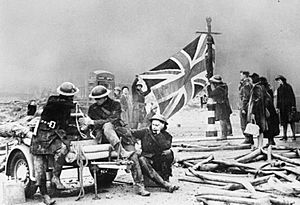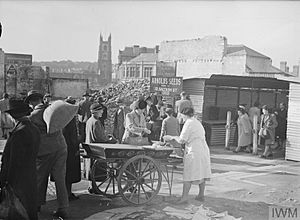Plymouth Blitz facts for kids
Quick facts for kids Plymouth Blitz |
|||||
|---|---|---|---|---|---|
| Part of the Strategic bombing campaign of World War II | |||||
 Winston Churchill is cheered by workers during a visit to bomb-damaged Plymouth on 2 May 1941 |
|||||
|
|||||
| Belligerents | |||||
| Casualties and losses | |||||
| 1,174 civilians killed 4,448 injured 22,143 houses damaged or destroyed |
Unknown | ||||
The Plymouth Blitz was a series of heavy bombing attacks. These attacks were carried out by the German air force, called the Luftwaffe. They targeted the English city of Plymouth during World War II. These bombings on many British cities were known as the Blitz.
The main target for the German bombers was the royal dockyards at HMNB Devonport. Germany wanted to stop British ships from helping in the Battle of the Atlantic. This battle was about controlling the seas. Another city, Portsmouth, also had a royal dockyard and was attacked. Even though the dockyards were the main target, many ordinary people were hurt or killed. The dockyards kept working despite the attacks.
What Happened During the Plymouth Blitz?
The first bombs fell on Plymouth on July 6, 1940, in an area called North Prospect. Three people died in this first attack. In early 1941, five major bombing raids hit the city. These attacks turned much of Plymouth into rubble. The bombings continued until May 1944, with two smaller raids that month.
During the 59 bombing attacks, 1,172 civilians, who were not soldiers, were killed. Another 4,448 people were injured. The number of people living in Plymouth dropped a lot. It went from 220,000 at the start of the war to only 127,000 at one point. In 1941, most children were moved to safer places. This was part of the evacuation plan. On nights when an attack was expected, thousands of people were driven by lorries into the countryside. They often went to the edges of Dartmoor.
"[...] in this town that was wasting away in reddish trails of smoke, only a few citizens wandered: the others were still in hiding; or lay, all distress ended, under the ruins."
—André Savignon on dawn, 21 March 1941.
How Buildings Were Damaged
Many important buildings in Plymouth were hit during the Blitz. In March 1941, St Andrew's Parish Church was badly damaged by bombs. After the attack, a headmistress bravely put a wooden sign over the door. It simply said Resurgam, which is Latin for I shall rise again. This showed the strong spirit of the people during the war. This same idea was used at other damaged churches in Europe. Today, that entrance to St Andrew's is still called the "Resurgam" door. There is a carved stone plaque there to remember it.
Charles Church, Plymouth was also destroyed by fire bombs on March 20–21, 1941. This church was left in its ruined state. It now stands as a memorial to all the civilians who died during the Blitz.
The Laboratory of the Marine Biological Association was also severely damaged. This happened on the evening of March 20, 1941. It was located on the Plymouth Hoe. Later, important scientific work on how nerves send signals continued there.
On April 22, 1941, a bomb directly hit a public air-raid shelter at Portland Square. This terrible event killed 76 people. Almost 70 years later, the University of Plymouth built a new building on that spot. They named it after the incident to remember those who died. Only three people in the shelter survived that direct hit.
During the Blitz, Plymouth's two main shopping areas were destroyed. Almost every public building was also ruined. This included 26 schools, eight cinemas, and 41 churches. In total, 3,754 homes were completely destroyed. Another 18,398 homes were seriously damaged.
Rebuilding Plymouth After the War
The central streets of Plymouth, which were mostly from the Victorian era, were heavily damaged. Because of this, in late 1941, the City Council asked Professor Patrick Abercrombie for help. He was a famous town planner. His job was to create a plan to rebuild the city.
The plan, called A Plan for Plymouth, was finished in March 1944. It was co-written by James Paton Watson. The plan suggested a big change for the city. Main roads were moved around the city center. The old street layout of the city center, except for Union Street, was removed. In its place, a grand new view was planned. This view would stretch from the Naval Memorial on Plymouth Hoe to Plymouth railway station. New roads and modern buildings would line this new layout.
Plymouth was the only British city that kept its wartime rebuilding plans. The work to rebuild the city center started in 1948 and was finished in 1962.





